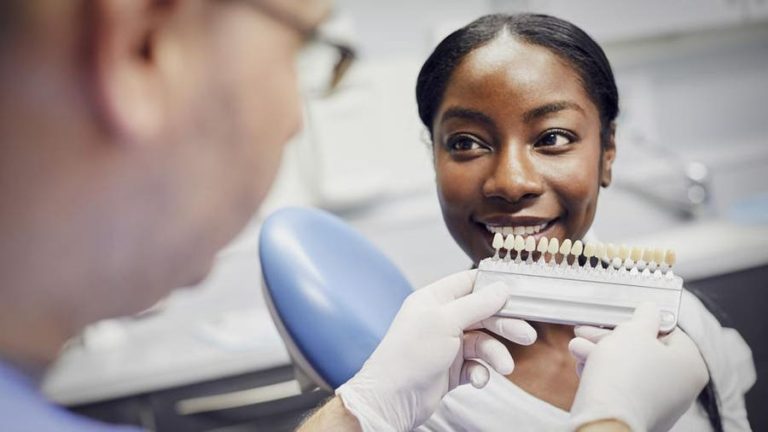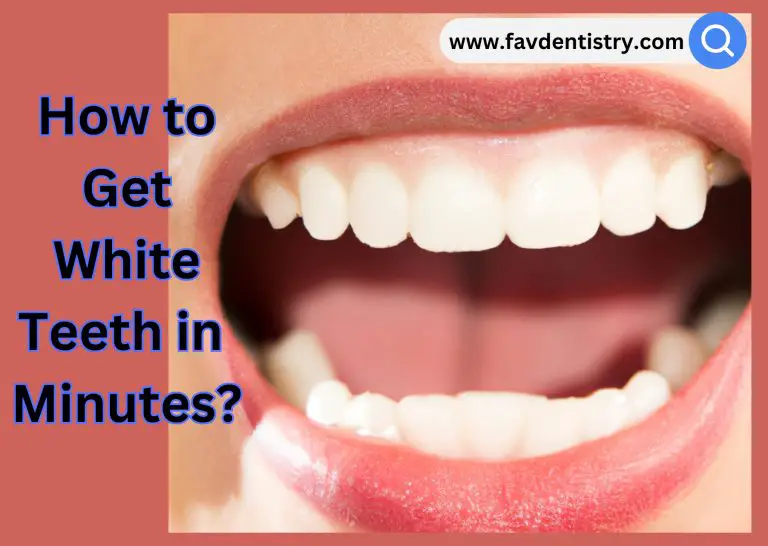Last Updated on 3 weeks by Dr. Michelle G. Brito
Teeth whitening at the dentist can be done through two main methods: in-office whitening and take-home whitening kits provided by the dentist. These procedures effectively remove stains and brighten the teeth, giving you a whiter, brighter smile.
Having a bright, white smile is one of the most sought-after dental improvements. Teeth whitening at the dentist offers a convenient and effective way to achieve this goal. Dentists offer two primary types of teeth whitening procedures: in-office whitening and take-home whitening kits.
In-office whitening involves professional treatment at the dentist’s office, while take-home kits provide the opportunity for at-home whitening under the dentist’s guidance. Both methods are highly effective in removing stains and enhancing the overall appearance of the teeth. We will explore these two types of teeth whitening procedures in detail, allowing you to make an informed decision about the best option for you.
Unveiling Teeth Whitening Types
Teeth whitening procedures at the dentist’s office offer effective and quick solutions for a brighter smile. One in-office bleaching technique involves the use of laser technology to enhance the whitening process. By applying a special bleaching gel to the teeth and then using a laser to activate the gel, this method can produce significant results in just one visit.
Another popular method is custom tray bleaching. This involves the dentist taking impressions of the patient’s teeth to create customized mouth trays. The trays are then filled with a bleaching gel and worn for a specified period at home. This technique allows for gradual teeth whitening, and the trays can be re-used for touch-ups in the future.
| Types of Teeth Whitening | Description |
|---|---|
| Laser Whitening Techniques | Involves the use of laser technology to activate bleaching gel for quick results. |
| Custom Tray Bleaching | Customized mouth trays filled with bleaching gel and worn at home for gradual whitening. |
| Zoom Whitening System | A combination of in-office bleaching and take-home trays for optimal results. |
Lastly, the Zoom Whitening System combines both in-office bleaching and take-home trays. The dentist first applies a special bleaching gel and uses a light source to activate it. Then, the patient is provided with custom trays and additional gel to continue the whitening process at home. This comprehensive approach ensures long-lasting and impressive results.
Personalized Dental Whitening Journey
Before embarking on a teeth whitening journey, it is essential to assess your smile’s current condition. Your dentist will evaluate various factors such as the nature and extent of discoloration, existing dental restorations, and overall oral health. This assessment helps determine the most appropriate teeth whitening method for you.
Based on the assessment, your dentist will recommend a personalized teeth whitening treatment plan. There are different methods available, including in-office professional whitening, take-home whitening kits, and even combination approaches. Each technique has its own advantages and considerations which your dentist will discuss to help you make an informed decision.
During the assessment, your dentist will also evaluate the sensitivity of your teeth. If you have sensitive teeth, they will take necessary precautions to minimize discomfort during the whitening process. Options such as desensitizing agents or using a lower concentration of whitening agents may be considered to ensure a comfortable experience.
The timeline for achieving desired results can vary depending on the chosen teeth whitening method. In-office treatments typically provide instant results, while at-home kits may require several weeks of consistent use. Additionally, the durability of teeth whitening outcomes varies based on individual habits and maintenance. Regular dental check-ups and good oral hygiene practices can help prolong the effects.
Beyond Basic Whitening Methods
There are several types of teeth whitening methods available at the dentist’s office. Beyond the basic whitening methods, there are dentist-guided at-home kits, which allow you to whiten your teeth in the comfort of your own home under the supervision of a professional. These kits often come with custom-made trays that fit your teeth perfectly and contain a bleaching gel that helps remove stains.
In addition to at-home kits, there have been innovations in LED and UV technology for teeth whitening. LED lights are used to activate the whitening gel, while UV lights can help enhance the whitening process. These technologies can help achieve faster and more effective results.
Furthermore, dentists also offer whitening treatments specifically designed for intrinsic stains. Intrinsic stains are stains that occur below the surface of the tooth enamel and can be caused by factors such as aging, trauma, or certain medications. These treatments target the deeper layers of the teeth to remove stubborn stains and restore the natural whiteness.
Overall, with various options available, you can consult with your dentist to determine the most suitable teeth whitening method based on your individual needs and goals.
Professional Whitening Deep Dive
Professional teeth whitening at the dentist entails various techniques, each with its own benefits and considerations. One common method involves the use of concentrated bleaching agents. These potent formulas contain active ingredients such as hydrogen peroxide or carbamide peroxide, which effectively eliminate deep-seated stains and discoloration.
During the whitening procedure, safety protocols are put in place to protect the patient’s gums and oral tissues. Gum protection may involve the application of a protective gel or the use of special barriers.
Moreover, professional teeth whitening techniques can be classified as either immediate or gradual whitening processes. Immediate whitening typically involves the application of a bleaching agent directly onto the teeth and the use of heat or light to accelerate the whitening process. Gradual whitening, on the other hand, involves the use of custom-made trays that the patient wears over a specific period, allowing the whitening ingredients to gradually whiten the teeth.
Breakthroughs In Teeth Whitening
There are several types of teeth whitening treatments available at a dentist’s office. One significant breakthrough in teeth whitening is the development of revolutionary gel formulations. These gels contain active ingredients that can effectively remove stains and brighten the teeth.
Another significant advancement in teeth whitening is light-assisted whitening. This technique involves using a special light source to enhance the whitening process. The light can activate the whitening gel, allowing it to penetrate the teeth more effectively and produce faster results.
Dentists also have the ability to tailor teeth whitening treatments based on the degree of discoloration. Different individuals may have varying levels of stains or discoloration on their teeth. By customizing the treatment, dentists can provide targeted and more effective whitening results.
Cost And Affordability Insights
When it comes to teeth whitening at the dentist, it’s essential to consider the cost and affordability of the various methods available. One of the economic aspects to consider is insurance coverage. Many dental insurance plans may not cover cosmetic dentistry procedures, including teeth whitening. However, some dental insurance plans might offer partial coverage or reimbursement for certain procedures.
If your insurance doesn’t cover teeth whitening, you may want to explore payment plans offered by the dental office. These plans allow you to divide the cost of the treatment into affordable monthly payments. Additionally, some dental offices offer in-house financing options.
Another economical option to consider is over-the-counter teeth whitening products. While these products are generally more affordable, they may not provide the same level of whitening as professional dentist treatments.
Ultimately, when choosing a teeth whitening method, it’s important to weigh the cost and affordability factors against the desired results and choose the option that fits your budget and expectations.
Post-whitening Care Recommendations
After getting your teeth professionally whitened at the dentist, it is important to follow proper post-whitening care recommendations to maintain the brightness of your smile. By adopting certain maintenance routines, you can ensure long-lasting whiteness and prevent staining or discoloration.
One crucial aspect of post-treatment care is to maintain a healthy diet and make conscious lifestyle choices. Avoiding foods and beverages that are known to cause staining, such as coffee, tea, red wine, and dark-colored sauces, can help preserve the whiteness of your teeth. Additionally, practicing good oral hygiene habits, including regular brushing and flossing, can prevent surface stains from building up.
Another consideration for maintaining your white smile is the option of touch-up treatments. Depending on your lifestyle and individual needs, your dentist may recommend periodic touch-ups to combat any potential surface or deep stains that may develop over time. These touch-up treatments are designed to supplement your regular oral care routine and ensure the ongoing brightness of your teeth.
| Maintenance Routines Post Treatment: | Diet and Habits for Lasting Whiteness: | Touch-Up Treatments: |
| Follow post-whitening care recommendations | Avoid foods and beverages that cause staining | Periodic touch-ups may be recommended |
| Practice good oral hygiene habits | Brush and floss regularly | Combat potential surface or deep stains |
Conclusion
Overall, there are several effective teeth whitening options available at the dentist, each tailored to meet specific needs. From professional bleaching to laser treatments and custom trays, you can achieve a brighter, whiter smile. Remember, it’s important to consult with your dentist to determine the best method for you.
With the advancements in modern dentistry, you can confidently restore your teeth’s natural luminosity and boost your self-esteem. Say goodbye to yellowed enamel and hello to a radiant smile!






